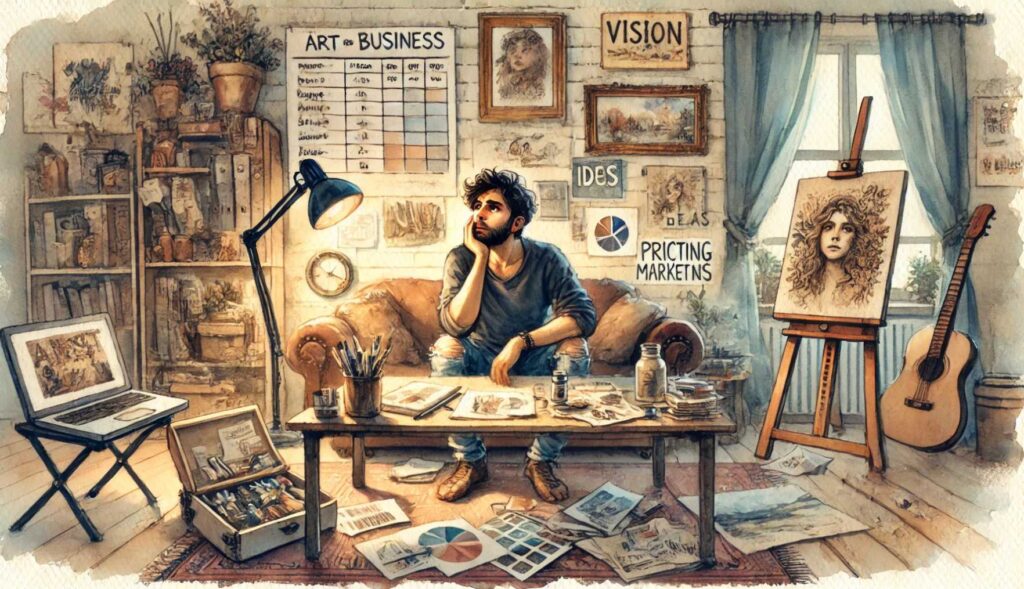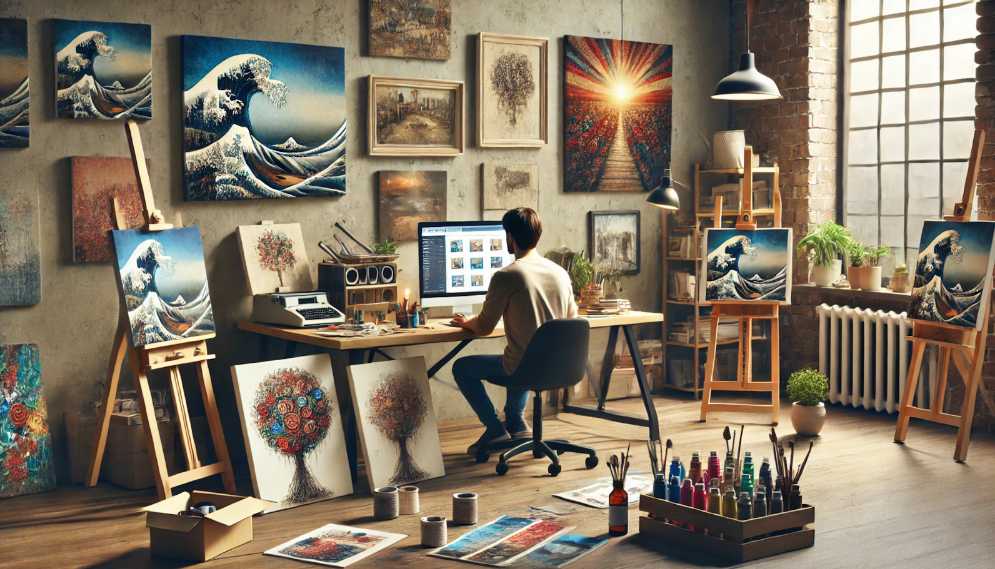Turning your passion for art into a business is a rewarding journey, but it requires careful planning and dedication. Whether you’re an emerging artist or an experienced creator, transforming your artistic talent into a profitable venture is possible with the right approach. In this guide, we’ll explore the steps necessary to succeed in the art business, from identifying your niche to managing finances and marketing your work.
Discovering Your Artistic Niche
The first step in building a successful art business is discovering your unique artistic niche. This involves identifying the style, medium, or subject matter that sets you apart from other artists. It’s essential to explore different techniques and approaches, allowing you to find a niche that not only resonates with your personal passion but also has market demand.

To assess market trends, observe what type of art is popular online, in galleries, and at exhibitions. Social media platforms and art communities can offer valuable insights into the current demand for specific art styles. By aligning your unique style with market trends, you can position yourself as a distinctive artist in a competitive field.
Building Your Brand as an Artist
Your brand is the face of your business, and for artists, it represents more than just a logo or color scheme. It’s about conveying your identity, artistic vision, and story to potential buyers. A cohesive brand helps establish credibility and trust with your audience.

Develop a well-organized portfolio that showcases your best work. Whether you display it on a website or social media, the portfolio should reflect your style and artistic journey. Consistency in your brand’s message, visual presentation, and even the tone of your communication will strengthen your brand presence.
Setting Up an Art Business Plan
Every successful business starts with a plan, and your art business is no different. A comprehensive business plan includes defining your artistic goals, identifying your target audience, and outlining your financial objectives.

To start, set clear, measurable goals for your art business. Do you aim to sell 50 original pieces this year or expand your reach to international markets? A financial plan should detail how you will generate income, cover costs, and reinvest in your business. This step provides structure and direction as you grow your business.
Pricing Your Artwork
Pricing your artwork can feel like a challenge, but it’s crucial to find the right balance. To set a fair price, you need to account for time, materials, and market standards. Here are some key factors to consider:

Flexibility: Adjust your prices as your reputation and demand grow.
Materials & Time: Calculate the cost of materials and the hours spent.
Research Market Rates: Compare prices with similar artists in your niche.
Factor in Experience: More experience often justifies higher prices.
Originals vs. Prints: Originals usually cost more than prints.
Creating Multiple Revenue Streams
Diversifying income streams is essential for artists looking to thrive in the art business. Relying solely on selling original works can limit growth, so exploring multiple avenues can enhance stability and success. Here are some potential income sources:

- Selling Original Artwork: Direct sales of unique pieces.
- Prints: Affordable reproductions of original works.
- Commissions: Custom artwork for specific clients.
- Art Classes/Workshops: Teaching others.
- Licensing Art: Apply art on products like fashion and home décor.
- Exhibitions/Fairs: Sell at galleries and art shows.
- Merchandise: Products featuring your art.
- Online Platforms: Use websites like Etsy or Saatchi Art.
- Digital Products: E-books, tutorials, and digital prints.
- Crowdfunding/Patreon: Gain support from fans for exclusive content.
By leveraging these streams, artists can increase their reach while maintaining creative control.
Marketing Strategies for Artists
Marketing your art effectively requires a mix of social media presence and a strong online portfolio. Platforms like Instagram and Facebook are perfect for sharing your work and engaging with your audience. Post consistently and offer insights into your creative process to connect with potential buyers.
Building a professional website is essential. Your website serves as both a portfolio and an online shop, allowing people to learn more about you and purchase your art directly. Include a blog, send newsletters, and join online art communities to boost visibility.
Finally, don’t forget in-person opportunities like art fairs and exhibitions to further grow your network.
Selling Art Online

Selling art online is an excellent way to reach a global audience and increase exposure. Platforms like Etsy, Saatchi Art, and Artfinder allow you to showcase your artwork to a wide range of buyers. To make the most of these platforms, focus on creating high-quality listings with clear images, detailed descriptions, and relevant keywords to help potential buyers find your work easily.
Each platform has its own features, audience, and requirements, so it’s important to research which one aligns best with your goals. The right platform can help you grow your art business globally.
Participating in Art Exhibitions

Art exhibitions offer invaluable exposure and networking opportunities. They give you the chance to showcase your art in front of collectors, gallery owners, and fellow artists.
Research local galleries, art fairs, and pop-up events to find suitable exhibition opportunities. Be prepared to submit an application, which typically includes your portfolio and artist statement. Being well-prepared for these events can open doors to new sales, commissions, and collaborations.
Networking and Collaborating with Other Artists

Networking is an essential part of growing any business, including art. Building relationships with fellow artists, curators, and industry professionals can lead to collaboration opportunities and valuable connections.
Join artist communities both online and offline, attend art-related events, and collaborate on projects with other creators. These interactions can help expand your network, gain referrals, and increase your visibility in the art world.
Managing Your Finances as an Artist
Financial management is often overlooked by artists but is crucial to long-term success. Keep track of your income, expenses, and profits using accounting software or a simple spreadsheet.
Additionally, understand the tax implications of running an art business. Depending on your country, you may need to set aside a percentage of your income for taxes or pay self-employment taxes.
Art Licensing as a Revenue Source
Art licensing is a profitable option that allows you to generate passive income by allowing others to use your art on products, from home décor to apparel.
To get started, research companies that specialize in art licensing and submit your portfolio for consideration. Licensing agreements typically involve royalties, so it’s important to understand the terms before signing any contracts.
Leveraging Online Courses and Workshops

Teaching can be a rewarding way to share your artistic knowledge while creating an additional revenue stream. Many artists offer online courses and workshops, which have become increasingly popular in recent years
Consider creating beginner-level courses or workshops in your area of expertise, and market them through your website or social media platforms.
Handling Art Commissions

Handling commissions is an excellent way to connect with buyers and create personalized artwork. However, it’s important to establish clear expectations with clients upfront.
Ensure that both parties agree on the project’s scope, deadline, and payment terms before starting. Written contracts help avoid misunderstandings and protect both the artist and client.
Navigating Legal Aspects of an Art Business
As a business owner, it’s essential to understand the legal aspects of selling art. This includes copyright protection, contracts, and intellectual property rights.
Familiarize yourself with the laws regarding the reproduction and sale of your work. Consider consulting a legal professional to help navigate any complex situations or to protect your rights.
Staying Motivated and Avoiding Burnout

Balancing creativity and business can be overwhelming. It’s essential to maintain a healthy work-life balance to prevent burnout.
Set aside time for self-care and pursue personal projects outside of your business. Regularly reflecting on your progress and goals will keep you motivated and energized.
Future Trends in the Art Business
The art world is constantly evolving, and new trends such as digital art and NFTs are reshaping the industry. Artists who embrace these trends can open up new opportunities and reach a broader audience.

Consider exploring emerging technologies and platforms that align with your style and goals.
Wrapping Up
Turning your passion for art into a thriving business is not just about creativity, but also strategy, persistence, and embracing new opportunities. Whether it’s selling your artwork online, networking at exhibitions, or exploring emerging trends like digital art and NFTs, the key is to stay adaptable. By managing finances, diversifying revenue streams, and balancing creativity with business, artists can grow their careers sustainably. Remember, it’s a journey—one that combines your love for art with smart business decisions. Stay motivated, keep learning, and enjoy the process.





